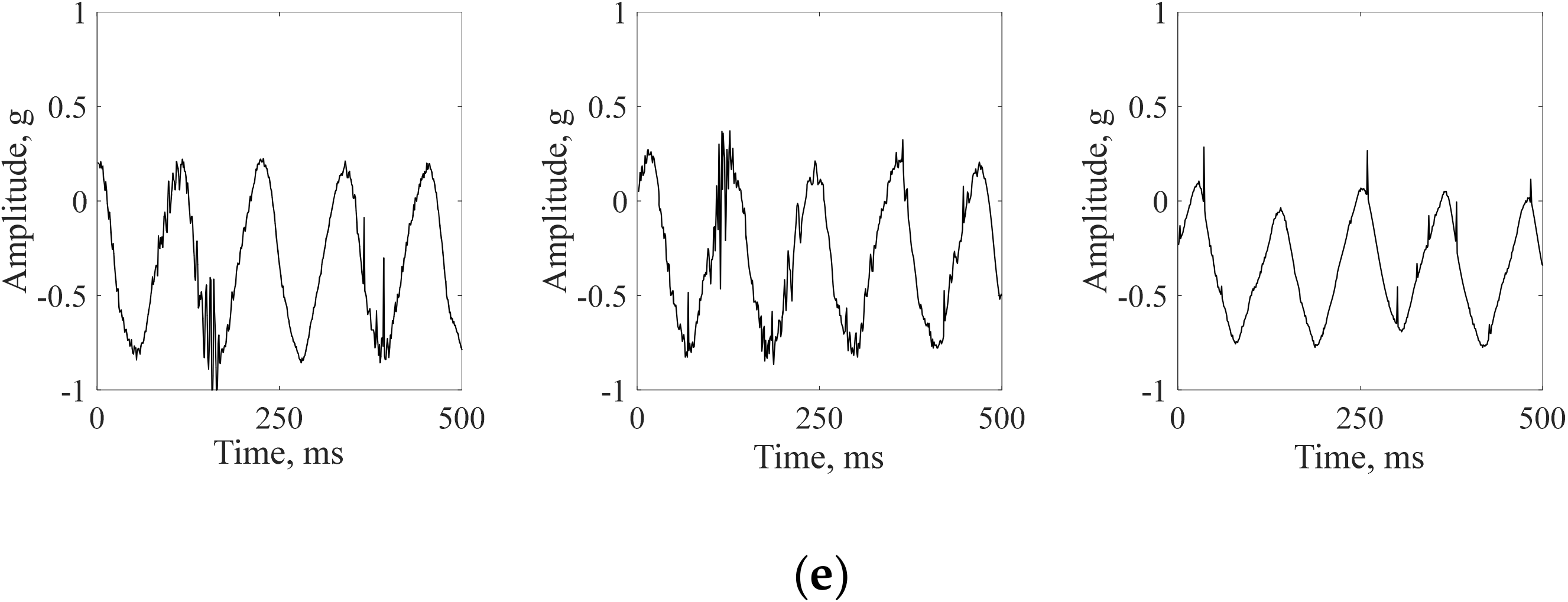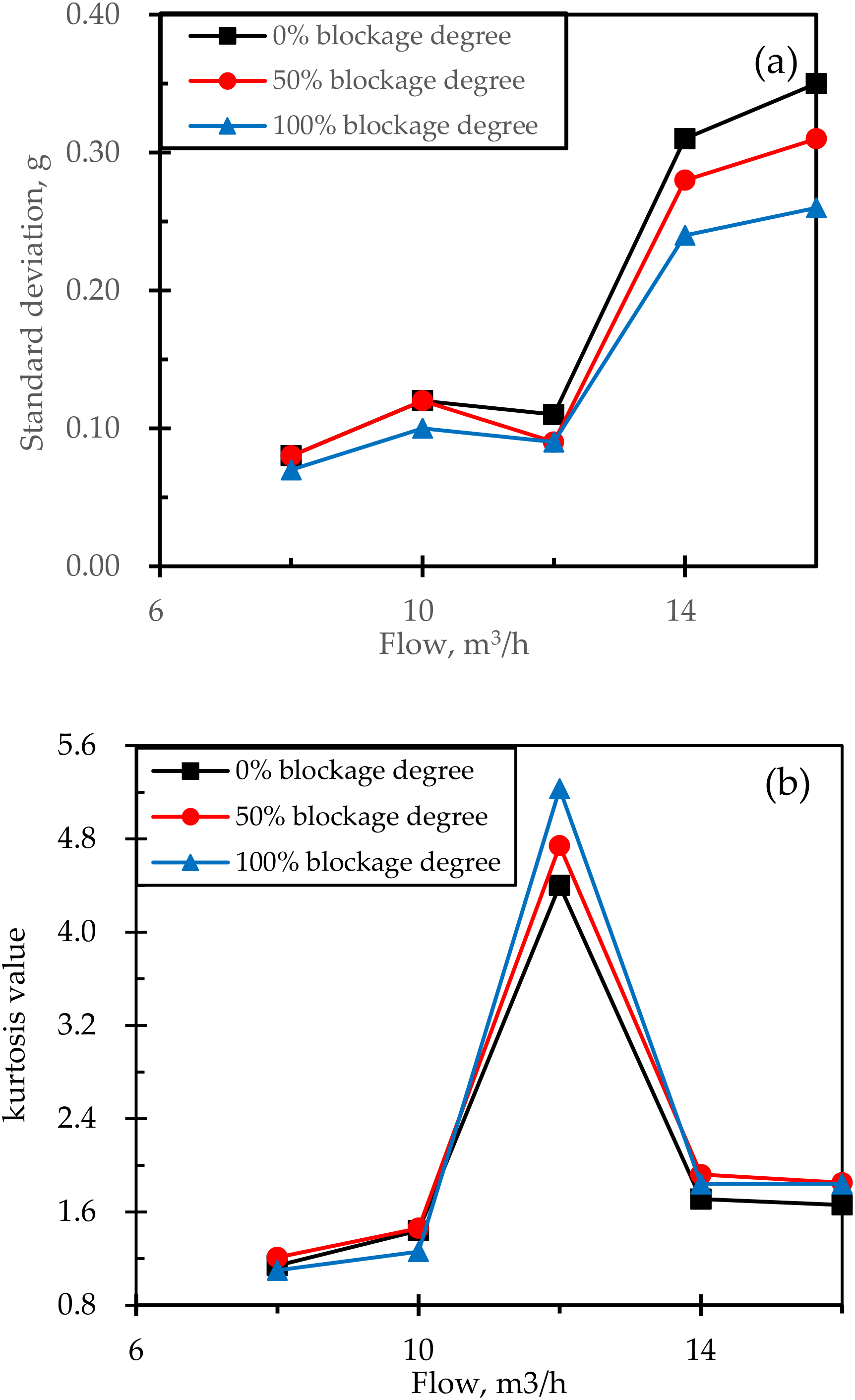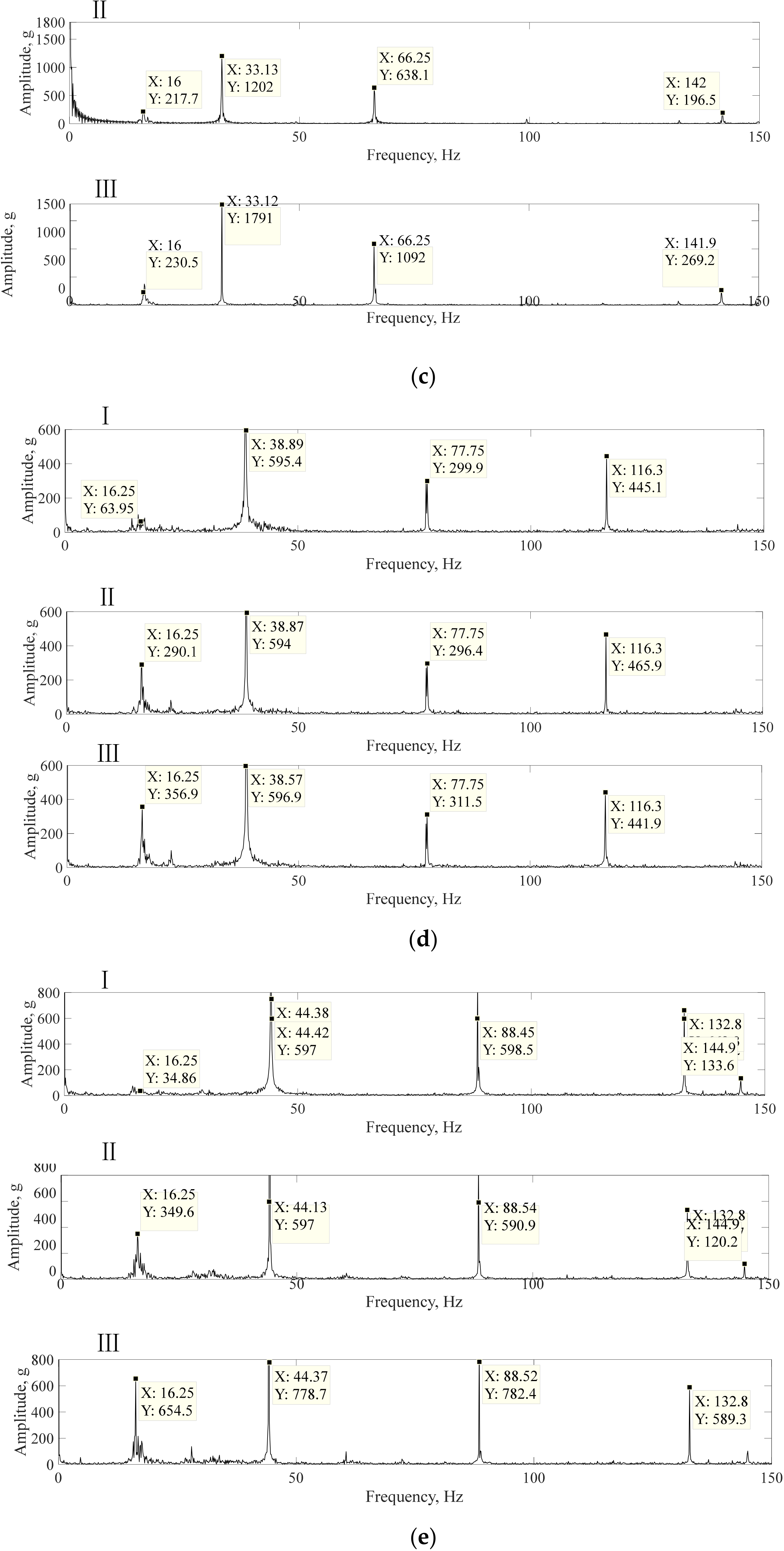Study of Blockage Diagnosis for Hydrocyclone Using Vibration-Based Technique Based on Wavelet Denoising and Discrete-Time Fourier Transform Method
Abstract
:1. Introduction
- (1)
- Explicitly describe the experimental approaches including the setup, procedure and data analysis.
- (2)
- Explore the appropriate installation location of vibration acceleration sensors for a lab-scale hydrocyclone.
- (3)
- Systematically research the blockage diagnosis using the time domain and the frequency domain based on the acceleration vibration information.
- (4)
- Critically analyze the online monitoring system for detecting and recognizing blockage faults of the lab-scale hydrocyclone.
2. Methodology
2.1. Experimental
2.2. Data Analysis
3. Results and Discussion
3.1. Sensor Installation Location
3.2. Diagnosis of Blockage
3.3. Online Monitoring System
4. Conclusions
- (1)
- Comparison of the frequency domain with different installation location displays that the farther away the installation location from the feed inlet the messier the frequency is. Therefore, the most regular frequency distribution can be seen with the installation plane near to spigot (i.e., z = −300 mm).
- (2)
- Time domain information displays that the acceleration amplitude under blockage degree 0%, 50% and 100% fluctuates as sine shape with increasing time, meanwhile the vibration frequency goes up with the increase of throughput. The distribution of four dimensional and five non-dimensional parameters for the time domain shows that with the increased blockage degree the standard deviation decreased gradually, while the kurtosis index firstly increased and then decreased. However, the other indicators changed irregularly. Thus, the standard deviation can be considered to estimate the diagnosis of blockage online.
- (3)
- Frequency domain distribution under different throughputs reveals similar trends, i.e., the characteristic peaks of acceleration amplitude can be divided in to two parts including the faulty frequency and multiple frequency, which were produced by the faulty blockage and the feed pump, respectively. Hence, the faulty peak located at 16–17 Hz can be used to judge the real-time blockage of hydrocyclones, i.e., the presence of the characteristic peak marks the blockage and its value is proportional to the blockage degree.
- (4)
- The application of the online monitoring system exhibits that the combination of the time domain and the frequency domain could effectively detect the running state and rapidly recognize blockage faults with high precision.
Author Contributions
Funding
Conflicts of Interest
Nomenclature
| Wavelet function | |
| Wavelet transform of original signal | |
| Wavelet transform after denoising | |
| Time domain signal reconstruction, g (9.81 m/s2) | |
| Average time domain, g (9.81 m/s2) | |
| Standard deviation, g (9.81 m/s2) | |
| Root mean square value, g (9.81 m/s2) | |
| Mean value, g (9.81 m/s2) | |
| Rectified mean value, g (9.81 m/s2) | |
| Peak index | |
| Waveform index | |
| Kurtosis index | |
| Pulse index | |
| Margin Index | |
| Signal after Fourier transform, Hz | |
| |F| | Average frequency domain, Hz |
References
- Vieira, L.G.M.; Damasceno, J.J.R.; Barrozo, M.A.S. Improvement of hydrocyclone separation performance by incorporating a conical filtering wall. Chem. Eng. Process. 2010, 49, 460–467. [Google Scholar] [CrossRef]
- Wang, C.; Chen, J.; Shen, L.; Hoque, M.M.; Ge, L.; Evans, G.M. Inclusion of screening to remove fish-hook effect in the three products hydro-cyclone screen (TPHS). Miner. Eng. 2018, 122, 156–164. [Google Scholar] [CrossRef]
- Bradley, D. The Hydrocyclone: International Series of Monographs in Chemical Engineering; Elsevier: Amsterdam, The Netherlands, 2013.
- Wang, C.; Chen, J.; Shen, L.; Ge, L. Study of flow behaviour in a three products hydrocyclone screen: Numerical simulation and experimental validation. Physicochem. Probl. Miner. Process. 2019, 55, 879–895. [Google Scholar]
- Chen, L.; You, Z.; Xie, H.; Zhang, H.; Li, Y.; Wei, Z. Fluidized hydrocyclone for continuous centrifugal concentration. Sep. Sci. Technol. 2017, 52, 1283–1288. [Google Scholar] [CrossRef]
- Li, X.; Xu, H.; Liu, J.; Zhang, J.; Li, J.; Gui, Z. Cyclonic state micro-bubble flotation column in oil-in-water emulsion separation. Sep. Purif. Technol. 2016, 165, 101–106. [Google Scholar] [CrossRef]
- Wasilewski, M. Analysis of the effects of temperature and the share of solid and gas phases on the process of separation in a cyclone suspension preheater. Sep. Purif. Technol. 2016, 168, 114–123. [Google Scholar] [CrossRef]
- Dueck, J.; Farghaly, M.; Neesse, T. The theoretical partition curve of the hydrocyclone. Miner. Eng. 2014, 62, 25–30. [Google Scholar] [CrossRef]
- Antunes, M.; Medronho, R. Hydrocyclones. In Bradley Hydrocyclones: Design and Performance Analysis; Springer: Berlin, Germany, 1992; pp. 3–13. [Google Scholar]
- Wills, B.A.; Napier-Munn, T. Wills’ Mineral Processing Technology: An Introduction to the Practical Aspects of Ore Treatment and Mineral Recovery; Butterworth-Heinemann: Oxford, UK, 2015. [Google Scholar]
- Zhu, H.P.; Yu, J.; Zhang, J.B. A summary review and advantages of vibration-based damage identification methods in structural health monitoring. Eng. Mech. 2011, 28, 1–6. [Google Scholar]
- Goyal, D.; Pabla, B.S. The Vibration Monitoring Methods and Signal Processing Techniques for Structural Health Monitoring: A Review. Arch. Comput. Methods Eng. 2016, 23, 585–594. [Google Scholar] [CrossRef]
- Wakefield, B.J.; Lindner, B.S.; McCoy, J.T.; Auret, L. Monitoring of a simulated milling circuit: Fault diagnosis and economic impact. Miner. Eng. 2018, 120, 132–151. [Google Scholar] [CrossRef]
- Mei, S.; Liu, X.; Mei, S. Cell-filtering Based Multi-scale Shannon-Cosine Wavelet Denoising Method for Locust Slice Images. Int. J. Wavelets Multiresolut. Inf. Process. 2019, 17, 1950035. [Google Scholar] [CrossRef]
- Ong, P.M.; Galvez, M.C.; Vallar, E.; Shiina, T. Wavelet Denoising Applied to Light Emitting Diode Lidar Signal. Adv. Sci. Lett. 2017, 23, 1374–1378. [Google Scholar] [CrossRef]
- Smith, B.C. Fundamentals of Fourier Transform Infrared Spectroscopy; CRC Press: Boca Raton, FL, USA, 2011. [Google Scholar]
- Candan, C.; Kutay, M.A.; Ozaktas, H.M. The discrete fractional Fourier transform. IEEE Trans. Signal Process. 2000, 48, 1329–1337. [Google Scholar] [CrossRef] [Green Version]
- Bracewell, R. The Fourier Transform and Its Applications; McGraw-Hill: New York, NY, USA, 2005; Volume 34. [Google Scholar]









| Items | Value |
|---|---|
| Diameter of hydrocyclone | 150 mm |
| Diameter of inlet | 50 mm |
| Length of column | 150 mm |
| Length of vortex finder | 60 mm |
| Diameter of vortex finder | 44 mm |
| Angle of cone | 20° |
| Diameter of spigot | 12 mm |
| Test Number | 1 | 2 | 3 | 4 | 5 | 6 | 7 | 8 | 9 | 10 | 11 | 12 | 13 | 14 | 15 | 16 | 17 | 18 |
|---|---|---|---|---|---|---|---|---|---|---|---|---|---|---|---|---|---|---|
| Throughput (m3/h) | 18 | 18 | 18 | 8 | 8 | 8 | 10 | 10 | 10 | 12 | 12 | 12 | 14 | 14 | 14 | 16 | 16 | 16 |
| Frequency (Hz) | 50 | 50 | 50 | 22 | 22 | 22 | 28 | 28 | 28 | 33 | 33 | 33 | 39 | 39 | 39 | 44 | 44 | 44 |
| Concentration (g/l) | 120 | 120 | 120 | 120 | 120 | 120 | 120 | 120 | 120 | 120 | 120 | 120 | 120 | 120 | 120 | 120 | 120 | 120 |
| Blockage degree (%) | 0 | 0 | 0 | 0 | 50 | 100 | 0 | 50 | 100 | 0 | 50 | 100 | 0 | 50 | 100 | 0 | 50 | 100 |
| Items | Models | |
|---|---|---|
| Time domain algorithm | ||
| Discrete wavelet transform formula | (1) | |
| (2) | ||
| Wavelet denoising process | (3) | |
| Time domain signal reconstruction | (4) | |
| Average time domain | (5) | |
| Dimensional analysis index | ||
| Standard deviation | (6) | |
| Root mean square | (7) | |
| Mean value | (8) | |
| Rectified mean value | (9) | |
| Dimensionless analysis index | ||
| Peak indicator | (10) | |
| Waveform indicators | (11) | |
| Pulse indicator | (12) | |
| Kurtosis index | (13) | |
| Margin Index | (14) | |
| Frequency domain algorithm | ||
| Discrete-time Fourier Transform | (15) | |
| Average frequency domain | (16) | |
| Throughput (m3/h) | Standard Deviation | Root Mean Square | Mean Value | Rectified Mean Value | |||||||||||
|---|---|---|---|---|---|---|---|---|---|---|---|---|---|---|---|
| Blockage Degree (%) | Blockage Degree (%) | Blockage Degree (%) | Blockage Degree (%) | ||||||||||||
| 0 | 50 | 100 | 0 | 50 | 100 | 0 | 50 | 100 | 0 | 50 | 100 | ||||
| 8 | 0.08 | 0.08 | 0.07 | 0.40 | 0.37 | 0.37 | −0.39 | −0.36 | 0.36 | 0.39 | 0.36 | 0.36 | |||
| 10 | 0.12 | 0.12 | 0.10 | 0.34 | 0.34 | 0.35 | −0.32 | −0.32 | −0.34 | 0.32 | 0.32 | 0.34 | |||
| 12 | 0.11 | 0.09 | 0.09 | 0.34 | 0.37 | 0.38 | −0.32 | −0.35 | −0.37 | 0.33 | 0.35 | 0.37 | |||
| 14 | 0.31 | 0.28 | 0.24 | 0.44 | 0.43 | 0.44 | −0.32 | −0.33 | −0.37 | 0.38 | 0.37 | 0.38 | |||
| 16 | 0.35 | 0.31 | 0.26 | 0.49 | 0.45 | 0.46 | −0.34 | -0.33 | −0.37 | 0.35 | 0.34 | 0.38 | |||
| Throughput (m3/h) | Peak Indicator | Waveform Indicators | Pulse Indicator | Kurtosis Index | Margin Index | ||||||||||
| Blockage Degree (%) | Blockage Degree (%) | Blockage Degree (%) | Blockage Degree (%) | Blockage Degree (%) | |||||||||||
| 0 | 50 | 100 | 0 | 50 | 100 | 0 | 50 | 100 | 0 | 50 | 100 | 0 | 50 | 100 | |
| 8 | 1.22 | 1.46 | 1.28 | 1.02 | 1.02 | 1.01 | 1.24 | 1.49 | 1.28 | 1.14 | 1.21 | 1.10 | 3.16 | 4.16 | 3.57 |
| 10 | 1.45 | 1.53 | 1.39 | 1.06 | 1.06 | 1.04 | 1.53 | 1.62 | 1.44 | 1.44 | 1.46 | 1.26 | 4.80 | 4.99 | 4.23 |
| 12 | 0.01 | 0.49 | 0.59 | 1.12 | 1.08 | 1.07 | 2.63 | 2.16 | 2.22 | 4.40 | 4.74 | 5.23 | 8.07 | 6.14 | 5.91 |
| 14 | 0.10 | 0.06 | 0.10 | 1.24 | 1.24 | 1.19 | 2.68 | 2.59 | 2.58 | 1.71 | 1.92 | 1.84 | 7.08 | 7.05 | 6.85 |
| 16 | 0.05 | 0.06 | 0.11 | 1.24 | 1.20 | 1.10 | 2.36 | 3.07 | 2.18 | 1.66 | 1.85 | 1.84 | 6.80 | 9.00 | 5.79 |
© 2020 by the authors. Licensee MDPI, Basel, Switzerland. This article is an open access article distributed under the terms and conditions of the Creative Commons Attribution (CC BY) license (http://creativecommons.org/licenses/by/4.0/).
Share and Cite
Wang, G.; Liu, Q.; Wang, C.; Dong, L.; Dai, D.; Shen, L. Study of Blockage Diagnosis for Hydrocyclone Using Vibration-Based Technique Based on Wavelet Denoising and Discrete-Time Fourier Transform Method. Processes 2020, 8, 440. https://doi.org/10.3390/pr8040440
Wang G, Liu Q, Wang C, Dong L, Dai D, Shen L. Study of Blockage Diagnosis for Hydrocyclone Using Vibration-Based Technique Based on Wavelet Denoising and Discrete-Time Fourier Transform Method. Processes. 2020; 8(4):440. https://doi.org/10.3390/pr8040440
Chicago/Turabian StyleWang, Guanghui, Qun Liu, Chuanzhen Wang, Lulu Dong, Dan Dai, and Liang Shen. 2020. "Study of Blockage Diagnosis for Hydrocyclone Using Vibration-Based Technique Based on Wavelet Denoising and Discrete-Time Fourier Transform Method" Processes 8, no. 4: 440. https://doi.org/10.3390/pr8040440
APA StyleWang, G., Liu, Q., Wang, C., Dong, L., Dai, D., & Shen, L. (2020). Study of Blockage Diagnosis for Hydrocyclone Using Vibration-Based Technique Based on Wavelet Denoising and Discrete-Time Fourier Transform Method. Processes, 8(4), 440. https://doi.org/10.3390/pr8040440







